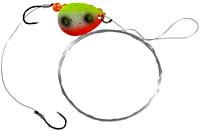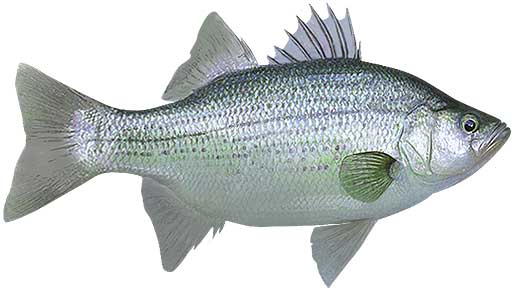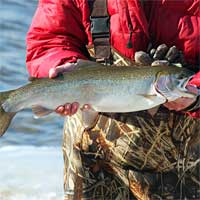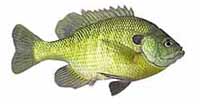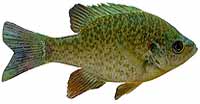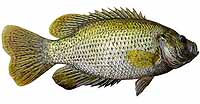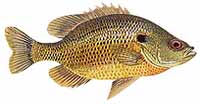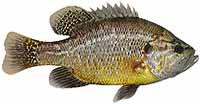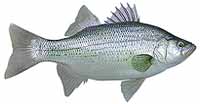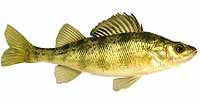Fishing Report For Blue Ridge Lake, GA
By Rick Seaman
Last updated on .
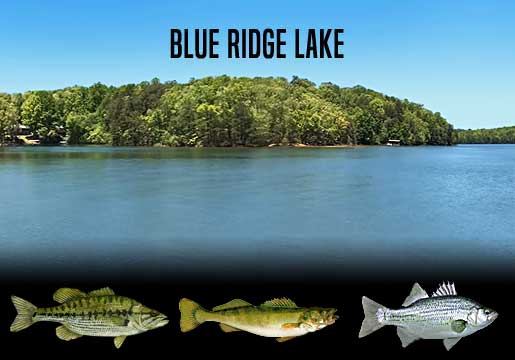
Fishing Reports
Popular Fish Species Blue Ridge Lake, GA
Spotted Bass
Current Report: Good To Very Good
Reported to be one of the best spotted bass fisheries in the state, Blue Ridge Lake continues to deliver. These spots also run bigger here, than most lakes in the state. Small worms, on a jighead or rigged Texas style, are a good choice of lures. Tube baits, jigs and spoons are also catching plenty of these feisty bass.
FALL. Fall has cooled the shallows, and spotted bass here followed schools of baitfish out of coves and bays, to deeper water. Here spoons, jig-head worms, and tube baits, are often very successful. Early, and late, in the day, spots feed in 8 to 12 feet of water. They move into 10 to 18 feet of water turns cold.
WINTER. Winter will draw them in large groups, around deeper structure, points and creek channels - anywhere there is baitfish. They can be found from 12 to 25 feet deep around deep flats, channel swings, and secondary points. Here they hold, feeding less aggressively, waiting warmer water to return in Spring.
SPRING. With water temperatures in the in the low 60's now, spotted bass have moved from deep wintering areas to depths of 2 to 10 feet, just outside spawning bays and coves. They are getting focused on the spawn. Once water warms into the high 60's, they move into even shallower water, and create nests, then lay their eggs. Immediately upon spawning, females move to deeper water around 15 feet deep. Males remain to guard the eggs, and then the fry. After a couple weeks, the males join the females. Deep crankbaits, spinnerbaits, small jigs, plastic worms and swimbaits are now catching plenty of spotted bass.
SUMMER. Spots are being caught on steep, rocky banks, ledges, humps, drop-offs and standing timber, in 10 to 25 feet of water, sometimes even deeper. At night they often venture shallower to feed. They tend to gather in small schools and hold, preferring to move up and down the water column on steep banks looking for food and ideal water temperatures. They are occasionally feeding shallow, early and late in the day, where they are being caught on topwater, crankbaits and swimbaits. Drop-shots, Ned rigs, and wacky-rigged stick worms are catching finicky bass when they are deeper. They feed here on shad, small sunfish and crawfish. During the hotter parts of the day, they are being caught on points and ledges 20 to 25 feet deep. Spots will also hold in the shade of heavy, shallower vegetation.
Walleye
Current Report: Fair To Good
Early in the morning, and from dusk to long after dark are good times to catch walleye, as they move shallower to feed.
FALL. Fall brought cooler temperatures to shallow water, drawing walleye and baitfish back toward deeper haunts. Walleye continue to be a major draw for anglers. Locals report catching nice walleye on long points, flats along the river and creek channels, and structure off shore. Jigs, swimbaits, spoons, crankbaits, jerkbaits, and spinnerbaits are all historically good for catching walleye this time of year. Early and late in the day finds them in 12 to 25 feet of water, mid day they hold 15 to 30 feet deep. Later in Fall, they move out slightly deeper. Dragging jigs, bottom bouncers, or worm harnesses with nightcrawlers or leeches, around ledge drop-offs is catching walleye fairly consistently. Watch for the bigger walleye to be slightly deeper than the majority of the school.
WINTER. This Winter, fishing for walleye has been pretty good through the ice, as it has been for the last few years. Before, during and after the ice, anglers report catching them in the main basin area, in 15 to 40 feet of water, along deep creek channel edges, rocky humps and ledges. Steep drops in the area toward the dam are also producing during these cold months. They primarily feed on small fish, staying close to the bottom. After ice-out blade baits, jigs, swimbaits, spoons, deep-diving crankbaits, and worm harness spinners, all work while deep trolling or drifting.
SPRING. Early Spring brings warming water in the shallows, and draws walleye here to feed, especially rocky areas and inlet channels. In Spring work points, drop offs, submerged structure, rock ledges, flats and flats adjacent to deeper water. Here, in 2 to 10 feet deep, they will spawn once the water warms to the mid to high 40's. When they move shallow, bright colored jigs, tipped with minnows or nightcrawlers typically catch them. Spinnerbaits, jerkbaits and crankbaits are also working when walleye are up shallow. Afterwards, they move to 8 to 20 feet deep around creek inlets, shallow rock reefs, windblown rocky points and flats, shoals and ledges, nearby shore. They often stay in close proximity to their spawning locations. Main lake drop offs are producing nice fish.
SUMMER. Water temperatures rise in Summer, and walleye fishing is good if you can get your bait deep enough. Early in Summer, walleye tend to concentrate in 8 to 20 feet of water. Throughout Summer, early in the morning, and from dusk to long after dark are good times to catch walleye. At those times they move slightly shallower to feed in low-light conditions. Night fishing is often good in Summer, as well. The rest of the time they are cruising flats and creek channel edges, 15 to 40 feet deep , preferring the cooler temperatures. When the bite is slow, grubs and nightcrawlers, fished just off the bottom typically catch walleye.
White Bass
Current Report: Good
White bass are popular among anglers here. The area south of Lake Blue Ridge Recreation Area, into the Toccoa River, has been producing for years.
FALL. Now late Fall finds white bass following baitfish moving back out of shallow coves and bays, into 3 to 25 feet of water. Spoons, jigs, underspins and minnows are catching good numbers of whites. Later, once the shallows cool considerably from chilly Fall temperatures, schools of white bass, along with baitfish, move even deeper. They will relate to most any structure, which includes drops, humps, timber, and creek channels.
WINTER. Winter for white bass is a continuation of Fall patterns, except slightly deeper, around 10 to 30 feet. They are being caught on the same lures, but most are caught using a slower retrieve. They often concentrate in the main lake basin, deeper flats adjacent to the main channel, around drop offs, points and humps. Good reports come from anglers fishing drop-offs along Toccoa River channel edges.
SPRING. The Spring run, when white bass move into the river sections of the lake, inflowing creeks, or along windy points where they stay for several weeks. to spawn. This makes it easier to locate schools in 1 to 8 feet of water. Live minnows on a bobber, small swimbaits and small crankbaits all are working for white bass. White bass start their spawn run once the water temperature reaches the mid 50's. Early Spring is a prime time to fill the livewells with some fat white bass. Spinnerbaits, curly-tail jigs, underspins, small crankbaits, small jerkbaits, and most any lure that resembles baitfish, will catch these feeding whites. As the water temperatures continues warming, they move out of spawning areas, into slightly deeper water. Look for them following schools baitfish in 6 to 20 feet deep. Also, watch for feeding frenzies when they chase schools of bait to the surface, and the fishing can be spectacular.
SUMMER. Summer finds white bass congregating in the main lake area, following and feeding on baitfish. They tend to stay in 10 to 30 feet of water, moving up and down the water column with the baitfish. They are being caught on slow-rolled spinnerbaits, curly-tail jigs, underspins, spoons, blade baits and small crankbaits, depending on the depth of the baitfish. Middle of the lake channel edges, points and deeper flats hold both bait and white bass in the warmest months.
Fishing Video
Fish species to fish for...
Guide to fishing for largemouth bass, smallmouth bass, spotted bass, walleye, rainbow trout, brown trout, bluegill, green sunfish, redbreast sunfish, redear sunfish, rock bass, spotted sunfish, warmouth, white bass and yellow perch at Blue Ridge Lake in Georgia.
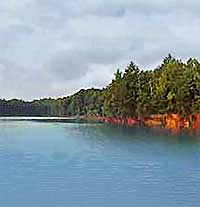 Blue Ridge Lake is a 3,300-acre lake with 65 miles of shoreline. It is located in the Chattahoochee National Forest. Anglers can choose from a wide variety of fish species, including spotted, largemouth and smallmouth bass, walleye, white bass, trout, perch and sunfish.
Blue Ridge Lake is a 3,300-acre lake with 65 miles of shoreline. It is located in the Chattahoochee National Forest. Anglers can choose from a wide variety of fish species, including spotted, largemouth and smallmouth bass, walleye, white bass, trout, perch and sunfish.
Primary fish species to catch
Click images for fishing tips and details about each species.
Today's Weather & Forecast
Fishing Boat Rentals
Click here for fishing boat rentals.
Public Boat Launch Ramps & Landings
Click here for boat ramps.
Marinas
Click here for marinas.
Fishing License
Click here for a Georgia Fishing License.
Map - Fishing & Access
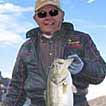 Rick Seaman is a fishing enthusiast with over five decades of fishing experience, a retired tournament fisherman, author of numerous published articles on fishing, and co-author of the book "Bass Fishing - It's not WHAT you throw, It's WHERE you throw it".
Rick Seaman is a fishing enthusiast with over five decades of fishing experience, a retired tournament fisherman, author of numerous published articles on fishing, and co-author of the book "Bass Fishing - It's not WHAT you throw, It's WHERE you throw it".
 Contact Information
Contact Information
Blue Ridge Lake Recreation Area
Blue Ridge, GA 30513
706 745-6928
Fishing lakes in each state
111925
Blue Ridge Lake, GA Report
GEORGIA


Fishing for smallmouth bass, walleye, bream and white bass in north-central GA.







